Illustration from Stylus in Wonderland, by O.J. Russell, Wireless World October 1954


The seemingly deeply confusing situation concerning different recording characteristics and when and where they were employed is simplified by having a historical perspective. Like most complicated situations, it didn't start out complicated: it evolved into something convoluted, and ultimately pretty chaotic at the point that LPs and shellac records co-existed, before it was brought under control by the, now ubiquitous, RIAA recording characteristic.
For the designer of the electrical reproducer, the task was simple too: to introduce a complementary characteristic by means of a bass-boost filter; entirely defined by the turnover frequency of the recording filter. With one difference, whilst a filter may easily be arranged to "cut" frequencies with no limit: it isn't possible to have an infinite "boost". So the compensating bass-restoration filter on the reproducer side had to be a shelving type with the shelf determined by the maximum boost at a certain frequency. We'll see later that this had ramifications later on.
There is some difficulty in determining the date at which recording pre-emphasis started to be employed in the USA. But Russell's article (Stylus in Wonderland, by O.J. Russell, Wireless World October 1954) gives us an important data point. He tells us that the idea of pre-emphasis for phonograph recordings came from FM broadcasting (where it is universally employed).
Now we know that Armstrong first demonstrated FM to the FCC in June 1936 and that the very first commercial stations were opened in January 1941. So it seems we can reasonably infer that pre-emphasis started to be employed at the tail-end of the thirties, around the time of the onset of the European war.
In Europe, only Decca embraced pre-emphasis of 78 RPM discs (as part of its FFRR recording system). EMI continued to use the original Blumlein characteristic until it discontinued production of 78 RPM records in Britain in the 1960s.
Pre-emphasis too was not defined as it is in the modern way with a time-constant. Instead, it was defined as the amount of boost (or cut on replay) at a specific frequency; usually 10kHz. Thus, a recording characteristic was defined, for example, as: turnover at 250 Hz with +5 dB boost at 10kHz, or, for short, 250 - 5.
All recording characteristics, up until the nineteen-fifties are simple variations of these two parameters: turnover and boost at 10kHz. The Devil is in the detail that the record companies all chose different turnover frequencies. And all chose different pre-emphasis curves from 0dB at 10kHz, to +16dB at 10kHz; a staggering range. Tone controls on preamplifiers dates from this period; they were necessary not to offer tonal choice, but to make the majority of records listenable at all.
Now, the idea of cutting the bass, to improve playing time, and to pre-emphasise the treble, to cut surface-noise, are both really good ideas (given certain assumptions) and more of both were gradually applied to records as the nineteen-forties progressed; especially in America. In fact, it is not a caricature to say that the main difference between pre-RIAA records from America and those from Europe in this period is that the European labels were much more cautious concerning the degree of pre-emphasis applied to 78 RPM records than were their American counterparts.
This wasn't simply fusty, European conservatism. America during this period wasn't a colonial power as were many of the European nations (especially Britain and France). In wealthy, domestic America, electricity had reached most homes by the 1930s and electrical reproduction of sound was the norm. Not so for European manufacturers for whom a substantial market for records lay in the far-flung outposts of the empire where mechanical gramophones remained the predominant method of reproduction well into the fifties. The European record companies were only too aware that the more equalisation applied to records, the worse they sounded on a mechanical gramophone.
Nevertheless, in the beating-heart of their massive entertainment industry, American record labels were especially enthusiastic in pursuing more bass-cut and more treble-boost until the two ideas practically "met in the middle" resulting in an almost entirely sloping characteristic with a gradual rise from bass to treble frequency extremes, with little or no level middle part; as in the following diagram.
The first stereo records were issued in the late 1950s but the takeup of the new technology was slow, so that stereo records were not widespread with consumers until the mid-to-late 1960s. There exits no formal linkage between stereo and RIAA New Orthophonic equalisation, yet the emergence of stereo forced the final crystallisation of recording characteristics around the RIAA characteristic via a commercial, evolutionary mechanism.
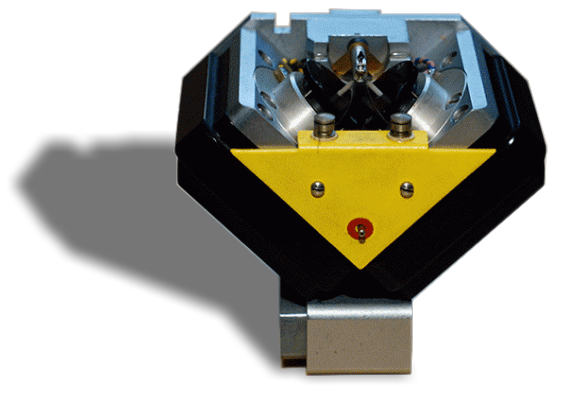 The recording characteristic as commited to the master acetate is a function of the lathe electronics. Often the recording characteristic is defined by the compensation circuits built around the cutter-head and amplifier feedback system and is integral to the correct operation of the recording lathe.
The recording characteristic as commited to the master acetate is a function of the lathe electronics. Often the recording characteristic is defined by the compensation circuits built around the cutter-head and amplifier feedback system and is integral to the correct operation of the recording lathe.
Equalisation crystallised with the introduction of stereo records because the change from mono spelt the death knell of many of the smaller lathe manufacturers and the retirement of older, mono lathes with miscellaneous equalisation circuits. Such was the necessary development time and money required to produce new, stereo equipment for a relatively small market that Westrex, Ortofon, Neumann and Haeco became the handful of companies able to produce decent, stereo cutter-heads by the end of the 1960s. These they supplied with the accompanying electronics designed for RIAA equalisation†.
Thus, the final standardisation of the recording characteristic to the RIAA curve had more to do with the introduction of stereo equipment and the commercial consolidation of the lathe market than it had to do with the decisions of the recording labels, mastering studios or standards organisations.
†There are a (very) few exceptions to this. See footnote 6.
Thus to the two numbers that defined a recording characteristic (turnover frequency and emphasis at 10kHz) was added a letter to mean:
Which is why RIAA is sometimes referred to as: 500R-13.7, meaning a 500 Hz turnover with a +20dB limit to the bass-shelf, and a 13.7 dB rolloff at 10 KHz. This nomenclature helps decode tables such as the one from High Fidelity Magazine in October 1955.
Time constants
Nowadays, the preference is not to use this code system, but to describe the recording characteristic with the time-constants of the electrical networks needed to encode or decode the characteristic. Thus, if the time-constant governing the HF pre-emphasis is t3, that governing the turnover is t2, and the that governing the corner of the bass-shelf is t1, then the overall response of the replay equaliser is given by the expression,
The bass-shelf
Remember the issue that, whilst it's possible to cut low-frequencies all the way to 0Hz when recording the disc, it isn't practical to boost all the way to DC on replay? In the early days, the choice of how much (and thus to what frequency) the boost would be correctly applied was simply the designer's choice. But as the post-war craze for "high-fidelity" got going, the need to define this became apparent. Moreover, it was appreciated that, if a shelving filter, instead of a simple low-pass filter was used on the record-side, it would be possible to match the equalisation exactly on the replay side. So a third parameter was introduced which defined the ultimate boost level of the bass-shelf.

Which curve to use...?
Of course, this is the important question and hopefully most questions are answered simply here. However a few of the finer points for discussion are covered here, especially in relation to the characteristics of early LPs. The recording characteristics of 78rpm (shellac) records is covered elsewhere.
as well as the relevant standards documents and a wealth of other articles and on-line resources. Including Peter Copeland's wonderful (if flawed)
Finally, our grasp of the historical perspective was greatly enhanced by the article,
In general we have always tried to source the original reference to verify any modern information.
Langford-Smith essentially presents the various recording characteristics in two sets of curves. Both of which are reproduced here.
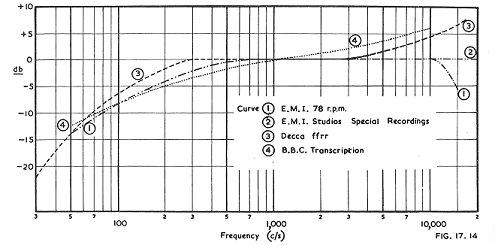
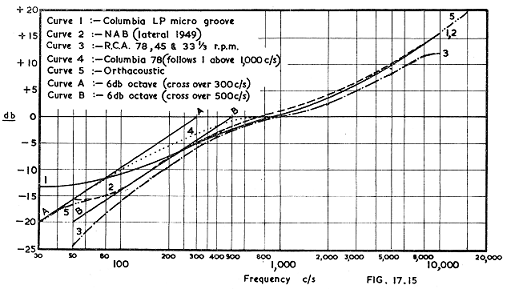
Original caption: Recording characteristics used by most American record manufacturers.
Moir, on the other hand, tabulated his data (and included useful correction circuits which we could simulate in SPICE). The key table (Table 7.4) from this reference is reproduced here with four columns added to cover the equalisation characteristics included in Stereo Lab and inspired from the QUAD 22 controller.
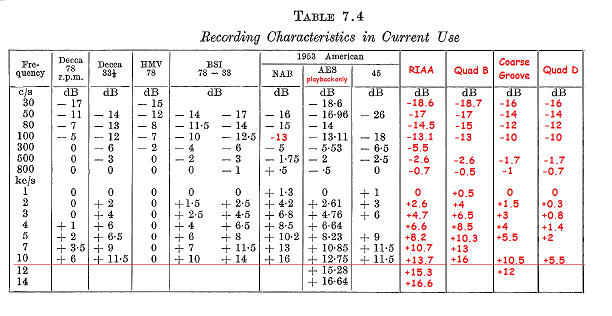
The problem with historic recordings and how to equalise them is threefold:
There is thus the necessity to be archaeologist, detective, reader of runes and pragmatist when deciding upon entering double-precision floating-point coefficients demanded by software equalisation.
To be sure, applying the wrong equalisation can have some fairly disastrous results. The differences between some recording characteristics is not subtle. For example, a Decca 78 equalised with RIAA equalisation will give +8dB too much bass at 100Hz and 10dB treble cut at 10kHz. Clearly we need to do a lot better than that!
However, not all mismatches are quite so disastrous, and here is where the QUAD 22 circuit and table were so clever because they apply intelligent and informed compromise equalisations to cover a wide range of different characteristics. Careful analysis of the QUAD table and Table 7.4 of Moir is informative and worthwhile.
However, with only four switchable equalisations, the Quad 22 still represents something of a compromise because there were certainly more than four recording characteristics! So, we have added some of our own. Our observations concerning the original and different characteristics employed at the end of the 78 and early LP era are given below.
Click this link for specifics and details of equalisation for shellac-era records.
Comparing Langford-Smith's EMI curve with Moir's tabulated data for HMV 78 we get a reasonable match. This is the old Blumlein 300-0 characteristic which is the appropriate equalisation for the reproduction so many European shellac-era records. Setting EQ-G in Stereo Lab matches this characteristic exactly. We believed 300-0 was a "78-only" characteristic, but Copeland (2008) informs us that this characteristic was used for LPs and 45s until mid July 1953.
Moir doesn't attribute these characteristics to a particular standard. But, from the dates, it must relate to BS. 1928:1955, that for Microgroove and Coarse-Groove records. This is the standards document which introduced 3180uS/318uS/75uS or RIAA equalisation for LPs, and 3180uS/450uS/50uS Coarse-Groove equalisation for 78s. The slight differences in the table compared with the values in the columns RIAA and Microgroove are thought to be calculation errors. This was, after all the age of log-tables and slide-rules. The time-constants referred to in the standard are identical.
Here we have excellent agreement between references¹. We can therefore be confident of this characteristic and subsequent equalisation (although, see Note. 1). Quad's Curve-B is exactly the NAB characteristic; as is the equalisation in Stereo Lab. The National Association of Broadcasters (NAB) changed their name to The National Association of Radio and Television Broadcasters (NARTB) for a short time after the introduction of television broadcasting. But they reverted to NAB again in 1958. This is why you will sometimes see the NAB characteristic called the NARTB characteristic. Note that this curve has its origins in equalisation of transcription discs used at radio stations. The NAB curve thus only ever applied to lateral-cut 33⅓ RPM discs: it was not applied to 78 RPM records.
Note: The NAB characteristic employs time constants of 3180µs, 318µs and 100µ exactly as the QUAD 22's B-curve. This truth is obscured by NAB's decision to put the 0dB reference at 700Hz rather than 1kHz which confuses everyone and is what appears to skew the table values slightly from Quad Curve-B.
RCA 33, 45 and 78
Here we have excellent agreement between Moir and Langford-Smith, but the frustration as to when and to what this characteristic was applied! It appears to be a curve sometimes referred to as Old Orthophonic (500N-12.7) which was possibly applied to 78s from 1947 - Aug 1952. In any case, it is very close to RCAs "New Orthophonic" standard of 1952 and we think New Orthophonic was a "tidy-up" of Old Orthophonic with a "tweak" (or correction) to the pre-emphasis level and a defined bass-shelf.
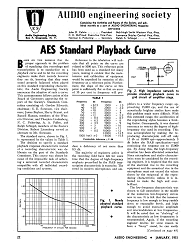 AES was not a recording characteristic at all: it's a replay standard. The American Audio Society's laudable idea was to try to get playback equipment manufacturers to standardise on a playback characteristic, thereby forcing the record manufacturers to "sort out their act" on the recording side. Their plan worked well, at least in the USA, and American manufacturers embraced this idea with vigour and many American labels cut their LP records to this standard prior to adopting RIAA as the Quad table and the Pspatial Audio Equalisation Guide indicate. Here, Moir lets us down as his tabulated values for AES are wrong, and don't even agree with his own published curve. Happily, other, older references survive.
AES was not a recording characteristic at all: it's a replay standard. The American Audio Society's laudable idea was to try to get playback equipment manufacturers to standardise on a playback characteristic, thereby forcing the record manufacturers to "sort out their act" on the recording side. Their plan worked well, at least in the USA, and American manufacturers embraced this idea with vigour and many American labels cut their LP records to this standard prior to adopting RIAA as the Quad table and the Pspatial Audio Equalisation Guide indicate. Here, Moir lets us down as his tabulated values for AES are wrong, and don't even agree with his own published curve. Happily, other, older references survive.
The characteristic is, in fact, very close to RIAA which was doubt one of the factors helping to encourage the adoption of the RIAA standard when it was eventually proposed (see below). By way of proof, the a graph of the error in the volume/frequency characteristic of an AES disc when replayed with the RIAA curve is shown below. The results are inside the AES standard limits of ±2dB. Interestingly, the results are much worse if an AES encoded disc is replayed with the Coarse Groove de-emphasis, so it remains a mystery why Quad recommend EQ-C for discs cut to the AES standard.
Nevertheless, the errors when an AES disc is replayed with RIAA are not inconsequential. The treble attenuation caused by RIAA replay is certainly perceptible. For that reason, Pspatial Audio have developed a specific AES de-emphasis algorithm (EQ-A3) which will guarantee the best sound from these discs.
Here's a final thought...... As the graph of the error in the volume/frequency characteristic of an AES disc when replayed with the RIAA curve illustrates, the results are inside the typical standard limits of ±2dB. This would have meant it would have been possible for cutting amplifiers equalised for AES (400-12) to have been left entirely un-modified and the claim to have been made that any discs were cut to the "new standard". Certainly, experiments made with discs cut well after the claimed RIAA implementation date often sound better with AES de-emphasis.
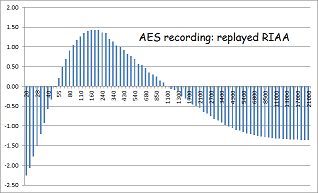
The Columbia LP characteristic is the NAB curve with a revised bass-shelf time-constant; from 3180µs (NAB) to 1950µs (Columbia)¹. This change to the bass-shelf is the origin of the term 500 modified or 500M you will see in older equalisation guides. HMV 33s produced in England were cut using this standard, as were LP records by Vanguard, Bach Guild, Cetra and Vox. If Columbia characteristic is replayed with the standard NAB curve (as with the Quad 22), the bass is too heavy. Pspatial Audio have therefore introduced a variation of NAB setting (EQ-B2) which is optimised for records cut using the Columbia characteristic.
For achivists working with acetates used for international exchange of radio programmes, it's worth noting that the CCIR issued a further recommendation in 1956 (Rec. 208 which specifically replaces Rec. 134 from 1953), which specified the time constants 3180µs/318µs/50µs. These time-constants are exactly the TELDEC values and thus EQ-A3 should be used to equalise these discs.
The intermediate recommendation (Rec. 208) was in effect from 1956 to 1959 until the CCIR recommended (Rec. 260) that all lateral-cut discs for programme exchange used the equalisation specified in IEC Pub. 98 - effectively RIAA (Stereo Lab EQ-A).
† Pspatial Audio is very grateful to Gert Willmann of Stuttgart Germany who provided documentation which enabled us to clarify and correct the previous recommendations for the equalisation choices in this section. We were previously unaware of the 1956 CCIR recommendation 208.
*In truth, the original CCIR standard (Rec 134 and Rec. 208) do not have a bass-shelf, this was added by the record companies for commercial discs.
London (usually meaning 500C-12)
Here we have a problem with classification, because the London name was adopted for different standards at different times. No London characteristic appears in the Langford-Smith's European curves or in Moir's table. But Langford-Smith describes a characteristic which he calls London in the text of which we have no other trace. Nevertheless, general useage for this characteristic is to describe the Decca 33⅓ characteristic tabulated by Moir. Quad suggest EQ-A (RIAA) for British LPs recorded with this characteristic. It's true this gives a pretty good match at high-frequency, but the bass is over-boosted. Pspatial Audio's EQ-A2 is a modified version of Quad setting A which is optimised for London records. A German language reference (kindly provided to Pspatial Audio by Wolfgang Leister) FUNKSCHAU, vol. 15 and vol. 16 of 1958 confirms that this 500C-12 characteristic is the London curve.
RIAA, RCA New Orthophonic, IEC No.98 (500R-13.7)
The RIAA standard equalisation is applied upon selecting EQ-A. This characteristic covers the vast collection of vinyl records from the middle sixties forward.
RCA New Orthophonic, IEC No.98 are alternative names for exactly the same recording equalisation, as is 500R-13.7. It's true that the later IEC standard added an additional LF breakpoint, but this was only for reproduction. See Pspatial Audio's position on the, so called, IEC Amendment.
Decca (often called 250-5.5, 3dB slope)
The curve published by Langford-Smith (which he refers to as the 1949 standard) is badly drawn: with sharp points of inflection from the flat, central section. Nevertheless, the curve and Moir's tables match well confirming that this is good data. Moir too has a version of this graph, and showing the same, suspicious idiosyncrasies, along with a recommended replay filter. It is probably these two drawings (and, perhaps a common predecessor) which have caused all the problems.

You will find everywhere modern references to a 1949 Decca characteristic of 640µs/53µs with a 3dB/octave pre-emphasis. But there are several problems with the 3dB/octave theory. A 3dB/octave filter is not an easy thing to construct and, whilst this wouldn't have been impossible on the recording side, it's hard to imagine how Decca would have envisaged the listener at home profiting from adopting a 3dB/octave characteristic. And, if it had existed, wouldn't it have been interesting enough that contemporary books such as Moir's or Langford Smith's would have covered it?
The key to the mystery is this......
Someone, whose identity is lost in the sands of time*, interpreted these inflection points in the Decca 78 curve as the time-constants. And this is the origin of the entirely fictitious Decca equalisation dubbed 640µs/53µs. This faux-pas is highlighted with red arrows in our version of Moir's curve (above). The indicated frequencies are not related to the time constants: they relate to the point at which the curve departs from the flat, central section. The coincidence is simply too marked for this not to be the logical explanation! Unable to explain why pre-emphasis which onsets at 3kHz only reached +5.5dB at 10kHz (when you would expect 11.5dB) gave rise to an erroneous belief in the mysterious 3dB/octave Decca curve!
*Quite possibly this derives from an article for a Versatile Phonograph Preamplifier by Paul W. St. George and Benjamin B. Drisko in the US magazine Audio Engineering: March 1949. Thanks to Wolfgang Leister for the detective work on this.
In fact, there is no mystery. All Decca's ffrs 78s are equalised with a pre-emphasis which onsets at 6.37kHz (time-constant of 25µs), a boost which is entirely consistent with a 5.5dB rise at 10kHz; exactly as illustrated. Moir's de-emphasis circuit further confirms this theory illustrating as is does that the HF pole is defined by the 16k resistor in series with a source impedance of 10k in parallel with 100k (i.e. ≈ 9k) in combination with a 1nF capacitor. (The reactance of the 100n is capacitor insignificant at these frequencies). Thus,
Finally, to guild the lily, here is the SPICE frequency characteristic of Moir's de-emphasis circuit which confirms all the above (the 3dB points are indicated).
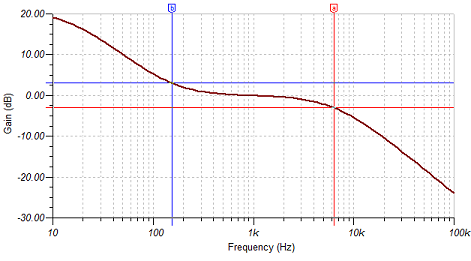
On the basis of Langford-Smith's curve, Moir's tabulated data and curve and this SPICE analysis we reject the existence of a 3dB/octave characteristic and recommend EQ-H for all Decca ffrs 78s.
Decca LPs (500C-11.5 in UK)
Some very early Decca LPs (only those before June 1950) used the 78 characteristic described above. After this date Decca used the Decca 33⅓ characteristic which is tabulated by Moir and which we could label 500C-11.5. Both the turnover (a perfect 3dB at 500c/s) and the pre-emphasis are as clear as day from the table. We have determined the time-constants of this curve to be 1590/318/60µs. The Quad 22 table refers to Decca UK LPs and suggests RIAA. It's true this gives a pretty good match at high-frequency, but the bass is over-boosted because of the 100Hz bass-shelf in the 500C-11.5 characteristic . Pspatial Audio's EQ-A2 is a modified version of Quad setting A which is optimised for Decca records.
There is some evidence that Decca in the US used various characteristics: including 500C-10.5, 400N-12 and 500B-16 so EQ-A, A1, B or C may be applicable in certain cases. But remember that Decca US (Decca Records Inc.) was an entirely different company to the Decca Records in the UK at that time. The history of Decca is given on our DNA of record labels page.
TELDEC (500R-10.5) - revisions here in 2019 & 2020
 Decca also founded a record company with Telefunken called Telefunken-Decca Schallplatten GmbH (TELDEC) originally to release classical recordings with the Bamberg Symphony Orchestra, the Berlin Symphony Orchestra and the Berlin Phil' which were released in Germany on the Telefunken label. A early focus in the TELDEC catalogue developed for early music and historical performance practice and, from 1958, TELDEC released these recordings under the sub-label Das Alte Werk. These recordings were and remain influential. They included the first significant recordings by Nikolaus Harnoncourt and the Concentus Musicus Wien,
Decca also founded a record company with Telefunken called Telefunken-Decca Schallplatten GmbH (TELDEC) originally to release classical recordings with the Bamberg Symphony Orchestra, the Berlin Symphony Orchestra and the Berlin Phil' which were released in Germany on the Telefunken label. A early focus in the TELDEC catalogue developed for early music and historical performance practice and, from 1958, TELDEC released these recordings under the sub-label Das Alte Werk. These recordings were and remain influential. They included the first significant recordings by Nikolaus Harnoncourt and the Concentus Musicus Wien,
In 1958 Funkschau magazine (Heft 16) reported that TELDEC had opted to manufacture their discs to a German DIN-Standard recording characteristic. This was outré given that this was several years after the lauded, so-called "standardisation" of the industry on RIAA. Yet, the German Standards Authority (DIN) did introduce a series of standards (DIN 45533, 45536 and 45537) in 1959 as a kind of "European RIAA" with reduced pre-emphasis.
The time constants of these DIN standards (common for 33⅓, 45 and 78 RPM discs) were 50, 318 and 3180 microseconds: close to RIAA, but different enough for recordings recorded with the former and played back with the latter to sound a little dull.
We previously believed these standards were proposed (in 1957) but never formally adopted — this information deriving from Peter Copeland's Manual of Analogue Sound Restoration Techniques 4. However, Copeland was mistaken and Pspatial Audio are very grateful to Gert Willmann of Stuttgart Germany who provided documentation which enabled us to clarify the status of these 1959 DIN standards.
In fact, the 1959 versions of DIN 45533, 45536 and 45537 were not "draft standards" at all. They do not have the word Entwurf (draft) on top of the first page, just in front of the date, and were fully-fledged German industry standards. It seems that the idea of a "European RIAA" equalisation characteristic based on time constants of 3180/318/50 µs really did have considerable traction after 1955 when American labels and most major European labels are widely reported to have adopted the new RIAA standard.
It must have been an industrial concern with some "clout" and vested interest to sponsor and drive through German national standards as late as 1959 which specified "non-RIAA" pre-emphasis.
It's not difficult to sympathise with the German position. In Europe (as explained above), record companies had largely done without pre-emphasis for the entire shellac era - a period during which the technique would have been helpful. It must have seemed like folly to introduce massive high-frequency boost to recordings on a new, low-noise medium. And the introduction of pre-emphasis introduced enormous challenges for the design of cutter-heads and drive amplifiers for the record-lathes for which European manufacturers were relatively unprepared compared with their American counterparts who had been applying pre-emphasis since the forties. Even the seemingly minor change from 50µs to 75µs pre-emphasis doubled the power-dissipation in the lathe cutter-heads at 10kHz.
Officially, the German standard for stereophonic LPs was defined in DIN 45547 which was finally adopted in November 1962. This document brought the standard equalisation in line with IEC98 (i.e. RIAA, 3180, 318, 75µs).
So, for how long was the older DIN 45537 in use?
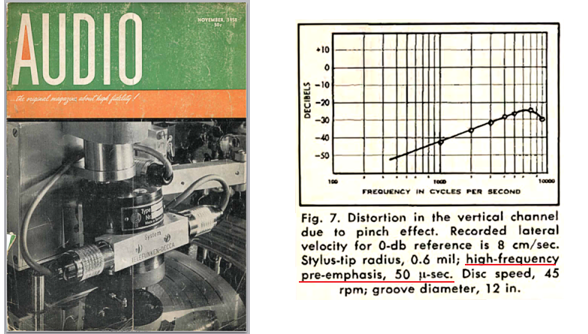
The RIAA Wikipedia article says this of the DIN (45537) characteristic, ❝The extent of usage of this curve is unclear❞ which is probably about right. But it may have been quite extensive. Copeland4 agrees and adds,
❝there was much heart-searching before Germany adopted 75 microseconds instead of 50, to bring them into line with the RIAA microgroove standard.❞
The TELDEC technical team writing in Audio Magazine in November 1958 present results (in this case for vertical tracing distortion) which indicate quite clearly that they were using 50µs pre-emphasis during the development of the stereo cutter-head system. Neumann lathe electronics provided for either RIAA or DIN equalisation up until 1966 and the introduction of the VMS 66 lathe electronics.6
Copeland tells us that Deutsche Grammophon made at least one stereo test disc using the older 45537 DIN standard (Deutsche Grammophon 99105)4 and many (maybe all) mono7 DGG recordings used this equalisation.
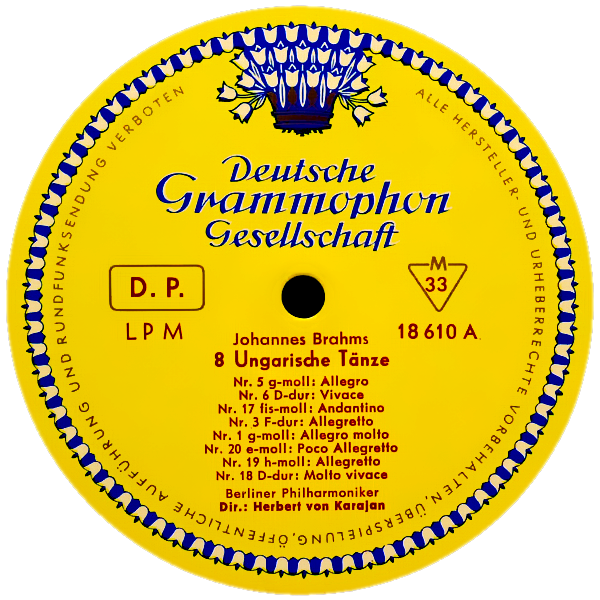
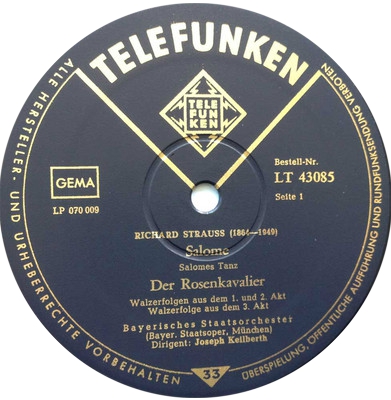
Deutsche Grammophon records are considered by some record collectors to lack the brilliance of sound quality of recordings by DECCA or HMV. But this is possibly due to the DIN recording characteristic being used instead of RIAA.7 Similarly, mono, Telefunken LPs indicate that DIN45537 and not RIAA recording characteristic was employed. The 33 symbol in a triangle specifies both records were manufactured to the DIN45537 standard.7
In order correctly to equalise these recordings, Pspatial Audio have made the appropriate modification of the RIAA characteristic in Stereo Lab called EQ-A3. This is the de-emphasis we recommend for mono TELDEC (Telefunken) LPs, mono DGG discs and quite possibly all other mono German-cut LPs of the same vintage.
You can listen to the difference between TELDEC equalisation and RIAA in the example given here. This is a recording of a mono TELDEC record (Cat. No. TW 30016, matrix: LDM 1226 believed to date between 1955 and 1958). The first part applies TELDEC EQ; the second RIAA. Necessarily subjective, the second version (where RIAA is applied) sounds as if the recording employed old, ribbon microphones: TELDEC equalisation results in an entirely more satisfactory balance.
The adoption of the double-circle logo on the labels of both stereo Telefunken and DGG LPs with the introduction of stereo in 1958, indicates that two-channel discs brought to an end the era of 50µs pre-emphasis. See notes six and seven.
But what are we to make of this?
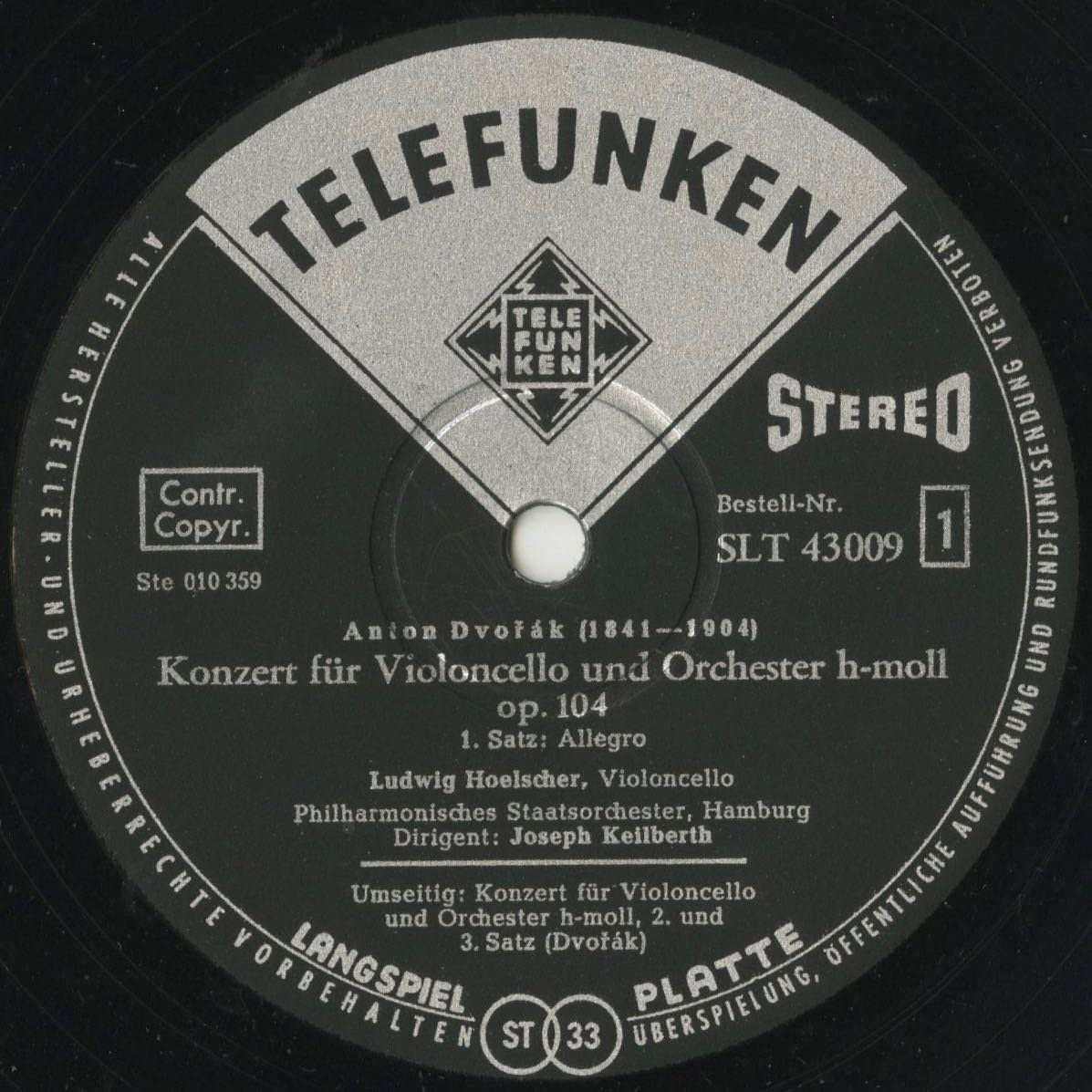
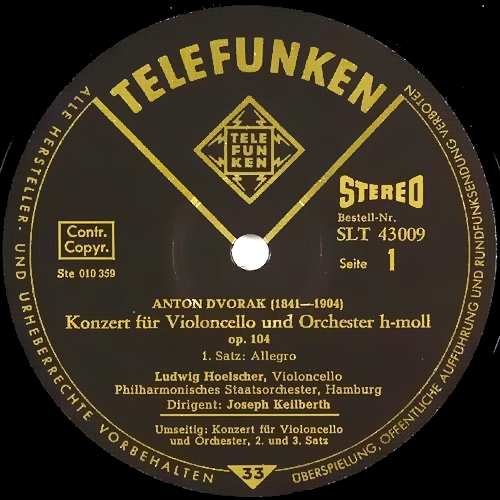
Two stereo, Telefunken discs. Same matrix number, different disc-standard logo — the first indicating RIAA characteristic, the second DIN45537. The mystery is even deeper when we read that the label on the right post-dates the label on the left.9 The only rational conclusion is to assume that the logos specified in the DIN standards for both mono and stereo records at some stage simply ceased to mean anything. Which brings us to the next section....
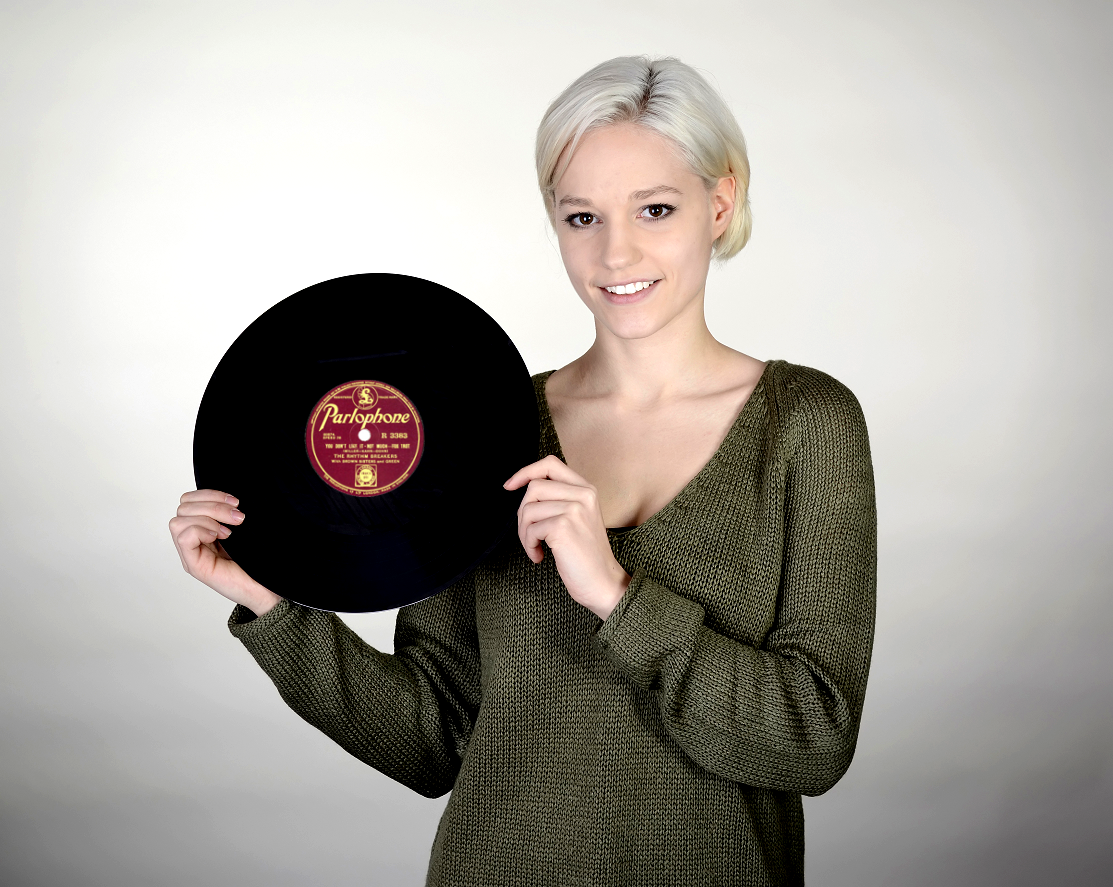
It is possible to audition any converted file directly from the application by right clicking on the file as it appears in the main window.
This is invaluable when comparing different conversions; for example of different phonograph equalisations. Simply make a version of each of the candidate equalisations and right click to hear each conversion.
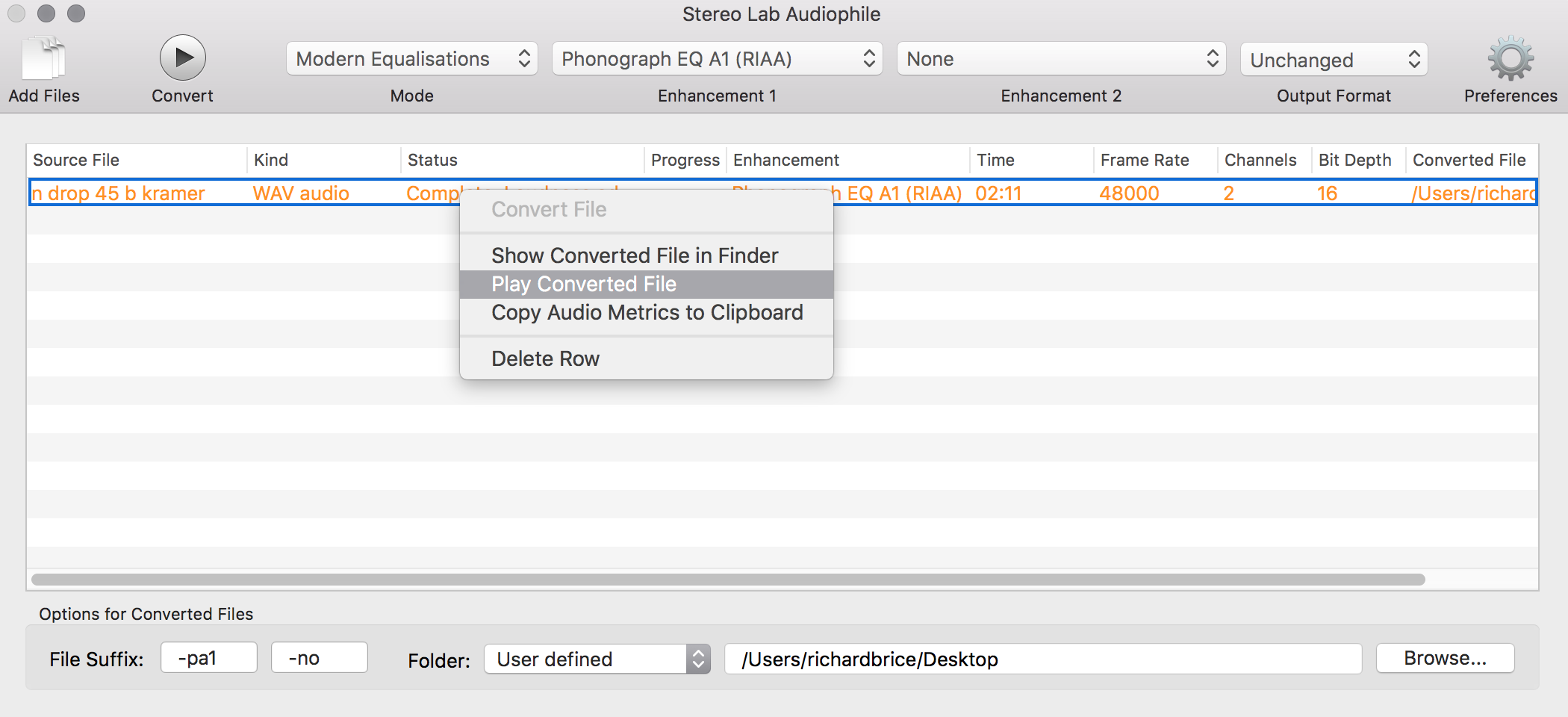
If you would like to see other, characteristics included in the Stereo Lab software, please contact support@pspatialaudio.com.
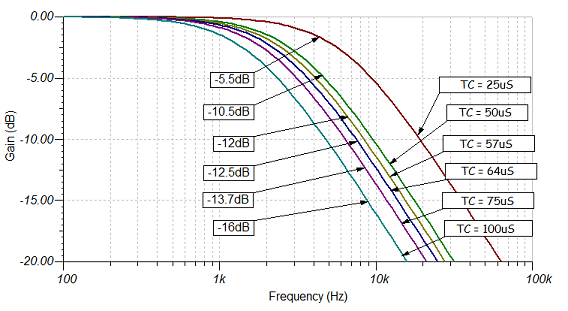
_004.png) 1. NAB and Columbia LP discrepancies Our opinion that Columbia and NAB characteristics share a turnover frequency of 500Hz and 16dB of attenuation at 10kHz is widely accepted (see Disc Recording Equalization Demystified. Galo, G. ARSC Journal, Fall 1996). But it is not universally held.
1. NAB and Columbia LP discrepancies Our opinion that Columbia and NAB characteristics share a turnover frequency of 500Hz and 16dB of attenuation at 10kHz is widely accepted (see Disc Recording Equalization Demystified. Galo, G. ARSC Journal, Fall 1996). But it is not universally held.
Although we think of the 33⅓ RPM discs as being introduced in 1948, this was only true of the introduction to the general public. Discs spinning at 33⅓ RPM pre-dated the commercial LP by twenty years.
The 33⅓ RPM speed was originally chosen increase the playing time of shellac records for synchronised audio in the cinema where the system was known as Vitaphone; the first commercially successful apparatus for the "talkies". Using a disc nearly 16 inches (about 40 cm) in diameter and rotating at 33⅓ RPM, the playing time of one side of a record was increased to 11 minutes which matched the running time of 1000 ft of film at 90 ft/min (24 frames/s).
Although Vitaphone system had been overtaken by sound-on-film systems by the mid-thirties in the cinema, the format of the 16 inch, 33⅓ disc was retained in radio broadcasting where these discs were either laterally or vertically modulated transcription discs; which is to say that they were acetates recorded only for occasional replay.
The NAB equalisation characteristic has its origins in the equalisation of lateral-cut 33⅓ RPM transcription discs which were (prior to distribution on magnetic tape) the principal medium of distribution of programmes by the American broadcast networks to their affiliated radio stations.
Clearly the broadcasters needed a standard for both recording and replay of these discs to ensure the sound quality remained consistent between the affiliated, local stations. Hence the involvement of the National Association of Broadcasters (NAB) and the publication of their document, Technical standards and good engineering practices of the National Association of Broadcasters for electrical transcriptions and recordings for radio broadcasting, March 1942.
The problems which arise in the interpretation of this standard have their origins in the manner in which the NAB committee sought to express the equalisation defined in this document. Instead of opting to use the default turnover and attenuation nomenclature. They drew a pre-emphasis curve (right), and required that,
.... The recorded frequency characteristic on laterally recorded records [shall] be as shown in Figure 2.
Fairly straightforward you would think, except.......
Very careful measurement and mathematical analysis of this curve by Pspatial Audio's friend Gert Willmann demonstrates that the transfer-function the curve describes cannot be obtained with any combination of three time-constants in the normal way: at least two more would be needed to obtain an accuracy in the order of 0.5dB.
Contagion
_small.png) When Columbia introduced the commercial LP, they understandably inherited the NAB recording characteristic: it was, after all, the de-facto standard for 33⅓ records.
When Columbia introduced the commercial LP, they understandably inherited the NAB recording characteristic: it was, after all, the de-facto standard for 33⅓ records.
Their only change was to revise the bass-shelf frequency to allow for poorer hum specifications in domestic equipment. The principal reference here is: Peter Goldmark, René Snepvangers and William S. Bachman. The Columbia Long-Playing Microgroove Recording System. Proceedings of the I.R.E., Vol. 37, No. 8, August 1949; from which the curve (left) is taken.
But, the Columbia team chose not to redefine the NAB characteristic, beyond the "tweak" to the bass-shelf. The Columbia characteristic thereby inherited the various mysteries inherent in the original NAB curve.
These facts presents us with a conundrum. Do we change the de-emphasis filter in software to reflect such an extended characteristic as near as possible to the curve drawn in the 1942 NAB standard? Or do we take a more pragmatic approach?
The challenge and fascination in developing a transfer-function which matches the hand-drawn curve is worthy enough, but the results are of little use unless they genuinely define the practical hardware filters which would have been used in the recording. After all, it is the practical recording filter which we are seeking to correct for in Stereo Lab.
And, we have some grounds for suspicion regarding the 1942 NAB standard....
By 1941, the principle of turnover, treble attenuation, and bass shelf was well established for the equalisation of records. It's very difficult therefore to imagine that the NAB would have assumed anything other than that the standard three time-constants would be incorporated into the equaliser transfer-function. Or that anyone building a practical equaliser to the NAB standard would have assumed more than three time-constants would be required. (Moreover, the concepts of "turnover" and "de-emphasis" are predicated on the idea of simple single-pole filters.)
Not for the first time in the development of Stereo Lab, we have sought the interpret historical mysteries not by what the literature (and even the standards) say, but by research into the practical solutions and engineering praxis adopted at the time.
You might say that for us, circuits speak louder than words!
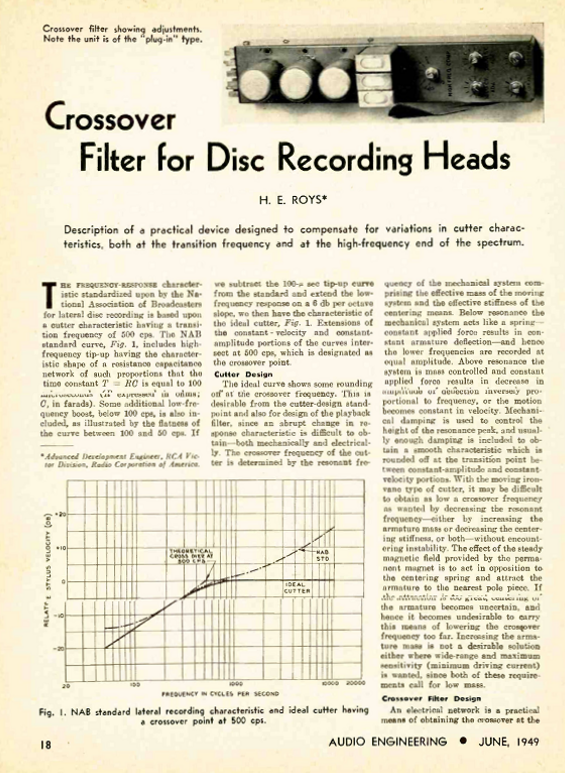
In this, we are fortunate to have discovered an article written by H.E Roys for RCA's Victor Division which describes a line equaliser designed to convert older RCA disc recorders to the "new" NAB transcription disc standard (Crossover Filter for Disc Recording Heads, Roys, H.E. Audio Engineering June 1949).
Roys starts by explaining the engineering requirement for the equaliser he goes on to describe,
The frequency-response characteristic standardized upon by the National Association of Broadcasters for lateral disc recording is based upon a cutter characteristic having a transition frequency of 500 cps. The NAB standard curve includes high-frequency tip-up having the characteristic shape of a resistance capacitance network of such proportions that the time constant T = RC is equal to 100 microseconds (R expressed in ohms; C, in farads).
Further verification comes from an article by an engineer in the laboratories department of General Electric (Recording Characteristic Simulator. Ghandi, S.K. Audio April 1957) which describes the development of a switchable pre-emphasis network for checking phonograph replay preamplifiers. Ghandi confirms the 500Hz turnover frequency and pre-emphasis "flat up to 1590 cps, and then rising at 6 db per octave."
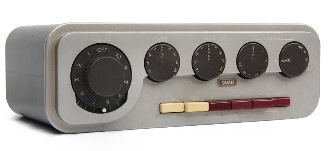 And finally, we have the Quad 22 preamplifier, introduced in 1959 and described here, which includes setting B which is: 3180µs/318µs/100µs. Why else would this setting have been included in a contemporary preamplifier if it was not to reflect NAB/Columbia praxis?
And finally, we have the Quad 22 preamplifier, introduced in 1959 and described here, which includes setting B which is: 3180µs/318µs/100µs. Why else would this setting have been included in a contemporary preamplifier if it was not to reflect NAB/Columbia praxis?
For the moment at least, the weight of the evidence is that the NAB characteristic (and its cousin the Columbia LP characteristic) - as applied in the field - incorporated a transition frequency from constant-amplitude response to constant-velocity response (turnover frequency) of 500Hz combined with 100µs pre-emphasis (responsible for 16dB gain at 10kHz). The later Columbia characteristic also modified the bass-shelf frequency to 100Hz (1950µs).
This is exactly matched by the complementary software equalisers for both NAB (EQ B) and early USA Columbia LPs (EQ B2) presently implemented in Stereo Lab.
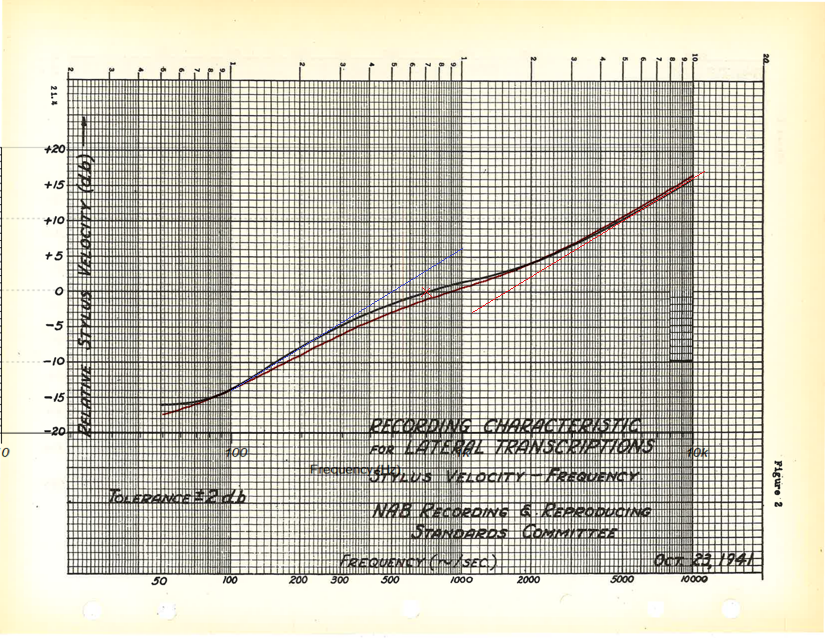
The following is a hypothesis as to how the NAB standard curve might have come to be drawn the way it is. The analysis is intriguing and has - at least - the advantage of demonstrating the deviation of the Stereo Lab filters from the drawn 1942 NAB standard curve.
A computer-drawn curve of a recording characteristic based on the three time constants: 3180µs; 318µs; and 100µs is overlaid on the NAB graph (right). The computer-drawn curve is brown against the black of the NAB curve.
Note that the deviation from the curve is never greater than ≈ 1dB. Therefore our filters are comfortably within the NAB standard anyway (it allows for ± 2dB from the drawn curve).
Interestingly, if 20dB/decade asymptotes are extrapolated from the ultimate attenution rate of the NAB curve, they intersect perfectly at 500Hz and 1591Hz on the 0dB axis. This has to be beyond coïncidence.
Overlaid in this way, it is very clear to see the way the NAB curve has been "pushed upwards" between 100Hz and a convergence point at 1.6kHz.
Our belief is that the origin of the eccentricity of the NAB standard curve may well be due to the draughtsman constructing a locus of points based on a circuit with the three time constants: 3180µs; 318µs; and 100µs but incorporating a further 0dB intercept at 700Hz. The requirement to accomodate this intercept forced the lower part of the curve to be stretched upwards. (Careful observation by Gert Willmann discloses that the graph was drawn as a "triptych" - with French Curves being used to draw separate LF, MF and HF sections.)
But why incorporate this extra intercept at 0dB at 700Hz?
We suspect that a 700Hz tone at standard recording level may well have been used as an alignment tone to 0VU within radio stations. Because of this operational issue, there would have been discussion in committee that a standard equalising filter and its associated amplifier must be aligned so that a 700Hz tone would emerge from the recording filter at unity gain. This must be enshrined in the standard curve.
What ought to have been done in the standard drawing was to move the entire curve upwards by 1dB to accomplish this intercept. But the draughtsman chose instead to "fiddle" the basic 3180µs; 318µs; and 100µs curve to incorporate the required 0dB line-up gain at 700Hz. Perhaps the curve was a modification of an earlier version of the curve which didn't provide the all-important indication that the recording filter must be unity-gain at line-up frequency?
By allowing a 4dB margin in the standard (2dB either side of the curve), such a modification to the drawing could have been made without fear that it defined a filter which was especially difficult to realise.
The ears - the measure of all things audio....
It is important in such a debate to keep in mind the degree of audible discrepancy between the characteristic specified in the 1942 NAB standard and a characteristic based on a transfer function defined by the three time-constants: 3180µs/318µs/100µs.
To that end, the same piece of music is processed with the two filters in the following audio example. The first part of the example assumes an exact match between the NAB curve (record and replay). The second part applies NAB curve encode and 3180µs/318µs/100µs decode. The final part is a derived difference signal between the two previous sections. It is hard to hear the dissimilarity. We must remember that we are talking of slight variations here.
2. The Radiotron Designer's Handbook, F. Langford-Smith, Wireless Press, Sydney, Fourth edition, 1952.
3. High Quality Sound Reproduction by James Moir, Chapman & Hall Ltd., London, 1958
4. Manual of Analogue Sound Restoration Techniques, Peter Copeland The British Library London, 2008 and available on line from the British Library site.
5. Stylus in Wonderland, by O.J. Russell, published in Wireless World magazine, October 1954.
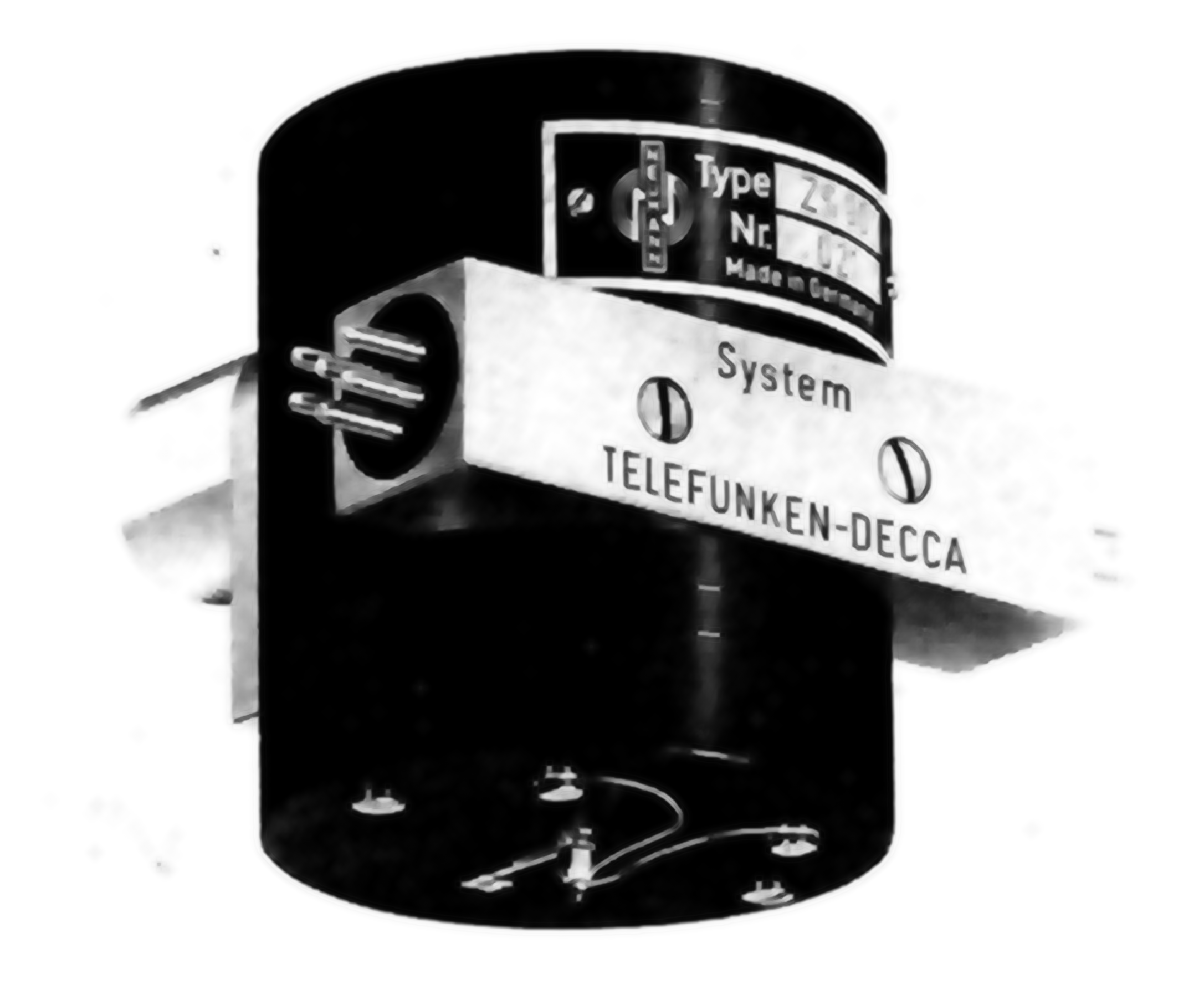
6. Generally for us, circuits speak louder than words!, so it's very interesting to look at the electronics accompanying the German lathes of the period of the late 50s and 60s to see what clues the recording hardware might give us as to the use (or not) of the TELDEC (DIN) equalisation.
Since TELDEC was only a research laboratory and record company, the job of actually manufacturing the cutter-heads and associated amplifiers fell to Neumann who made the TELDEC cutter available as a product (right) from October 1958. It was designed to be mounted on the Neumann AM-32b lathe and driven by a pair of Neumann LV60 tube (valve) power amplifiers.8
Unlike later lathe electronics, the record equalisation was accomplished in the power-amplifier in this design. The schematic is given here. Control click (right-click) for a larger version.
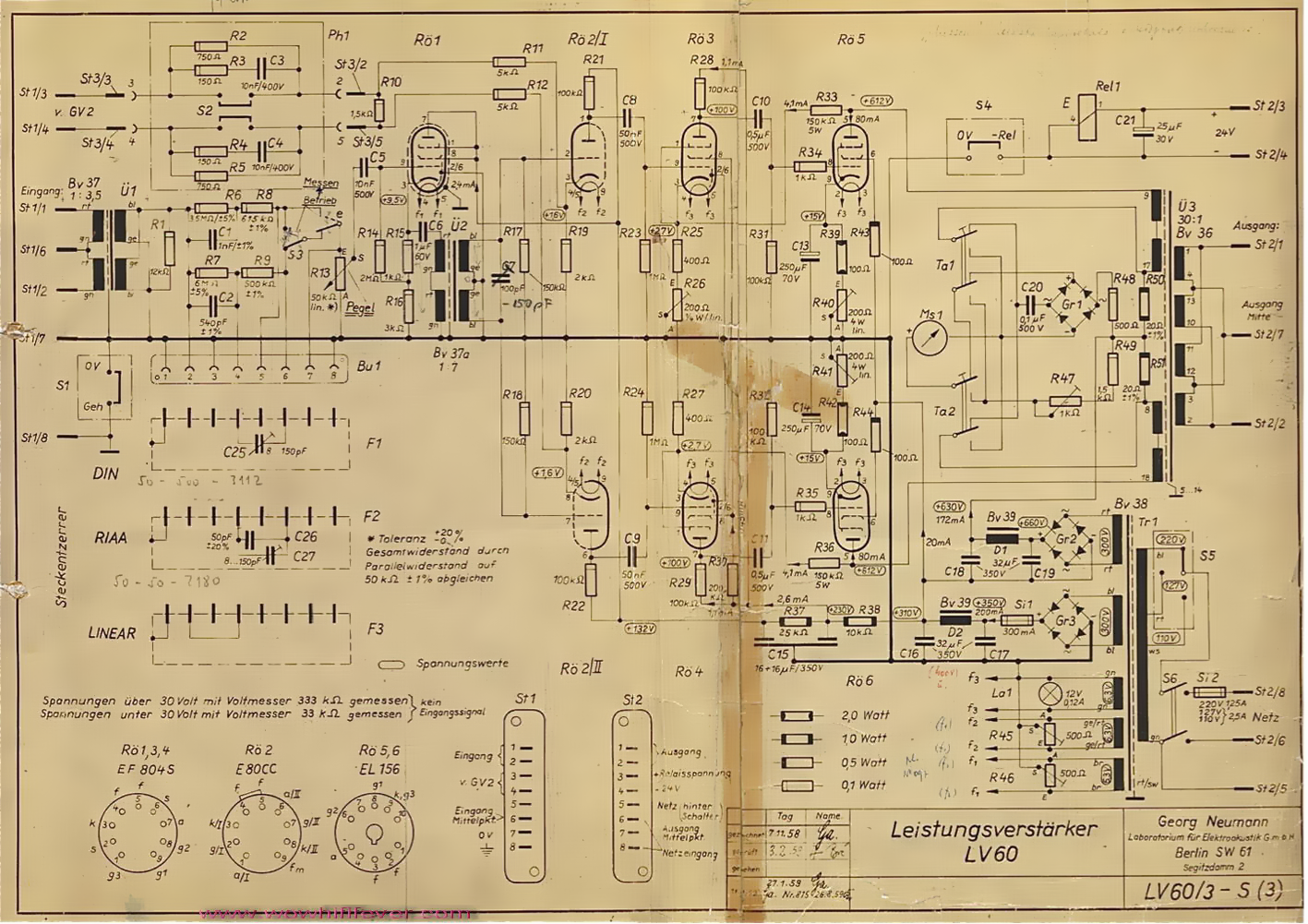
The LV60 is a push-pull, class AB amplifier using a pair of Telefunken EL156 power pentodes to deliver 60 watts into the recording-cutter coil. The equalisation is all performed in the passive RC network preceding Rö 1 (V1), the EF804 pentode — run as a triode cathode-follower here.
With the clever device of alternative plug-in equalisers (which plug into the socket Bu1), the recording equalisation could be switched between RIAA and DIN. As expected, the change only affected the high-frequency pre-emphasis (50µs or 75µs). The data sheet for the ZS90/45 (TELDEC) cutter makes specific reference to plug-in equalizers corresponding to the standard RIAA, DIN pre-emphasis curves.
A pair of LV60 power amplifiers were part of Neumann's stereo solution for disc cutting until the introduction of the VMS 66 in 1966. So stereo records cut with a DIN (45537) characteristic would certainly have been technically possible throughout this period. We know that, of the 25 systems assembled by the fall of 1958, twelve were installed in the Berlin and Hamburg cutting rooms of TELDEC and a somewhat smaller number at DECCA in London.8
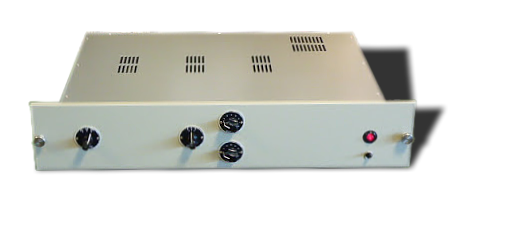 Another clue lies in the design of the Neumann dual-channel (and thus explicitly stereo) WV 2 Equalized Playback Preamplifier which was designed for QC listening and monitoring of stereo discs cut using the early Neumann system (and which now has a life as a high-end phono preamplifier amongst vinylistas in Japan and Korea). This unit too provided user-switchable DIN/RIAA playback equalisation.
Another clue lies in the design of the Neumann dual-channel (and thus explicitly stereo) WV 2 Equalized Playback Preamplifier which was designed for QC listening and monitoring of stereo discs cut using the early Neumann system (and which now has a life as a high-end phono preamplifier amongst vinylistas in Japan and Korea). This unit too provided user-switchable DIN/RIAA playback equalisation.
The later VMS 66 lathe recording-characteristic equaliser (SE66) was a separate unit and wasn't integrated with the transistor cutter-head drive amplifier (LV66). The design of the SE66 equaliser is discussed in detail here. This later module does not allow for switching to DIN (50µs) pre-emphasis, so we can safely assume that DIN equalisation was no longer required (or no longer catered for) by 1966.
7.
Note that the presence of the speed (33) in a triangle - intended to represent the groove shape - was a part of the Kennzeichnung (labelling) requirement of DIN 45537 (as well as 45533, 45536). It does not indicate CCIR equalisation as Copeland claims; except insofar as the intermediate recommendation CCIR Rec. 201 specifies the same time constants as TELDEC (3180µs/318µs/50µs).4
The presence of the 33 in a triange (with or without the M for mono) symbol emphatically indicates the recording is to DIN 45537 (mutatis mutandis if speed of the record is different) and uses the 3180/318/50µs characteristic. The standards documents say, the label must be clearly visible with a triangle V and the number 33 to indicate the shape of the groove and the speed; the letter M can also be added.
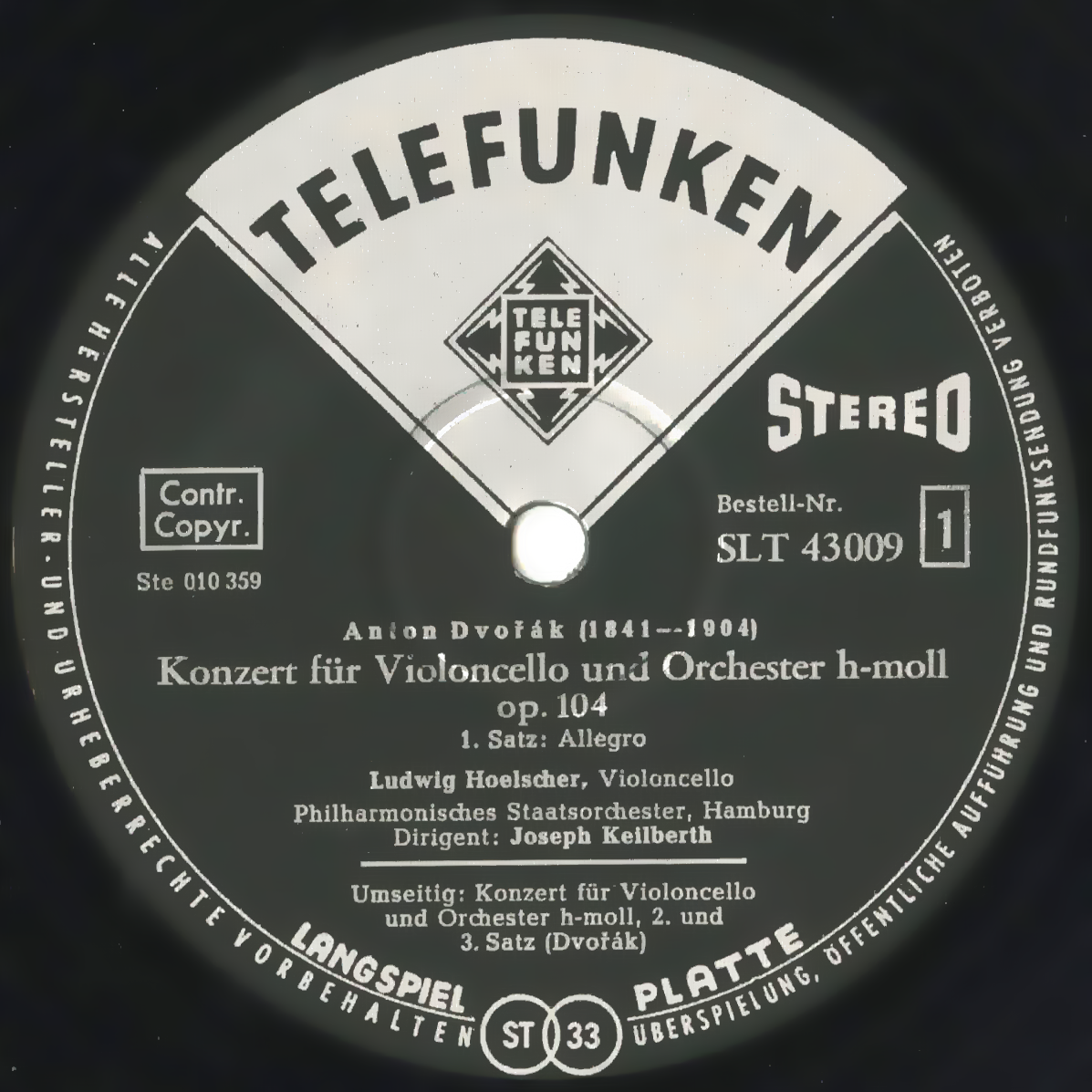 The indication that the later stereo standard was used is given by the double-circle with the letters St and numbers (eg. 33) depending on speed. This logo is specifically given in DIN 45547 under the title Kennzeichnung (labelling requirement) with the instruction, [this] label must be clearly visible to identify the shape of the groove and the revolving speed.
The indication that the later stereo standard was used is given by the double-circle with the letters St and numbers (eg. 33) depending on speed. This logo is specifically given in DIN 45547 under the title Kennzeichnung (labelling requirement) with the instruction, [this] label must be clearly visible to identify the shape of the groove and the revolving speed.
The "speed in triangle" was so widespread on Telefunken record labels it's easy to overlook its significance. Yet, when Telefunken issued its first stereo records, the label indicates the newer double-circle logo. The DIN 44537 labelling was no whimsy of the TELDEC drawing office.
Deutsche Grammophon (DGG) continued production of mono-only records until 1966 and these are clearly marked that DIN equalisation should be employed.

8. THE TELDEC MINIATURE STEREO CUTTERHEAD SYSTEM Temmer, S.F. Presented at the 10th Annual Meeting of the Audio Engineering Society Sept. 29 - Oct. 3, 1958
9. Vinylklassik - Erstausgaben Labelkatalog (Classic Vinyl - First editions, label catalogue) Hampel. H Engelsdorfer publishing company 2006
 Home page
Home page
For all support issues, go here.
For Pspatial Audio sales, email: sales@pspatialaudio.com
